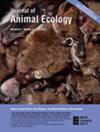Cyclic functional connectivity of Canada lynx (Lynx canadensis) populations across North American boreal landscapes
IF 3.7
1区 环境科学与生态学
Q1 ECOLOGY
引用次数: 0
Abstract



加拿大猞猁(lynx canadensis)种群在北美北方景观中的循环功能连通性。
连通性是由不适宜居住的生境基质对基因流动的渗透程度决定的。成功的基因流动需要分散的个体前往新的种群,在那里生存,并最终繁殖。因此,对连通性的检查必须同时考虑景观的渗透性和个体的生存模式,因为存活的个体是唯一具有繁殖潜力的个体。研究人员利用142只猞猁的207,957个迁移数据,研究了西北北方森林中加拿大猞猁(lynx canadensis)种群的功能连通性。作为雪鞋兔(Lepus americanus)的专业捕食者,猞猁的种群遵循10到12年的种群周期,比野兔的种群周期落后几年。我们使用综合步骤选择分析来量化栖息地选择,并使用贝叶斯计数过程实现包裹柯西生存模型来评估分散过程中的死亡风险。在种群数量下降之后,我们比较了不同行为状态和种群阶段的迁移模式和存活率。研究结果表明,在研究区域内,猞猁的扩散几乎没有完全的物理障碍,许多猞猁的扩散范围超过3000公里。对猞猁运动的阶梯选择分析表明,与居住猞猁相比,散居猞猁对低质量栖息地的容忍度更高,主要是在地形崎岖和靠近道路的地方。与居民相比,这些差异导致对分散的山猫的景观渗透性的估计更高。当考虑到生存模式时,在人口下降期间,居住和分散的猞猁之间的差异越来越明显。散居猞猁的存活率明显低于驻地猞猁。总的来说,这描绘了一幅在人口高的时候联系更紧密的景观,在人口低的时候变得越来越分散。加拿大猞猁种群似乎在整个景观中几乎没有不透水的屏障,但在种群数量下降期间,由于存活率降低,它们面临着低功能连通性的时期。这强调了维持高质量的避难所栖息地的重要性,在周期性低点之后,人口可能会出现反弹。
本文章由计算机程序翻译,如有差异,请以英文原文为准。
求助全文
约1分钟内获得全文
求助全文
来源期刊

Journal of Animal Ecology
环境科学-动物学
CiteScore
9.10
自引率
4.20%
发文量
188
审稿时长
3 months
期刊介绍:
Journal of Animal Ecology publishes the best original research on all aspects of animal ecology, ranging from the molecular to the ecosystem level. These may be field, laboratory and theoretical studies utilising terrestrial, freshwater or marine systems.
 求助内容:
求助内容: 应助结果提醒方式:
应助结果提醒方式:


